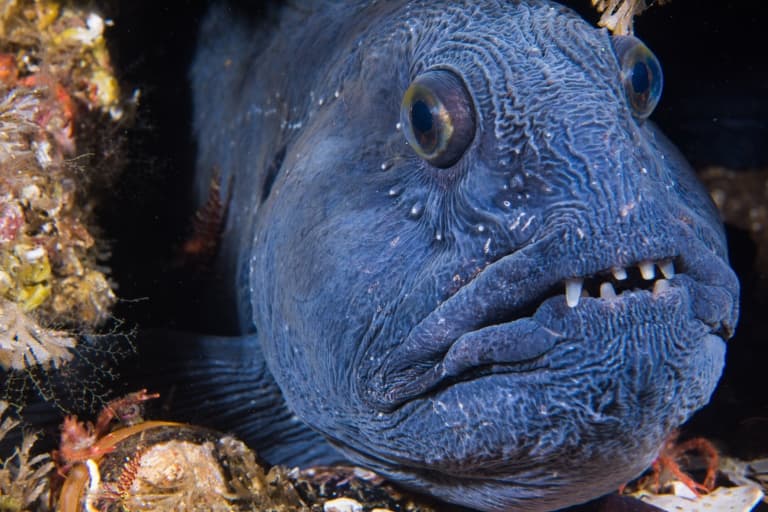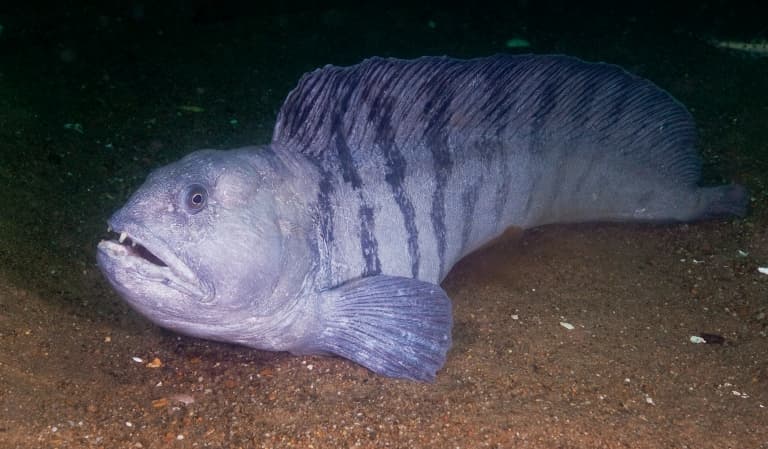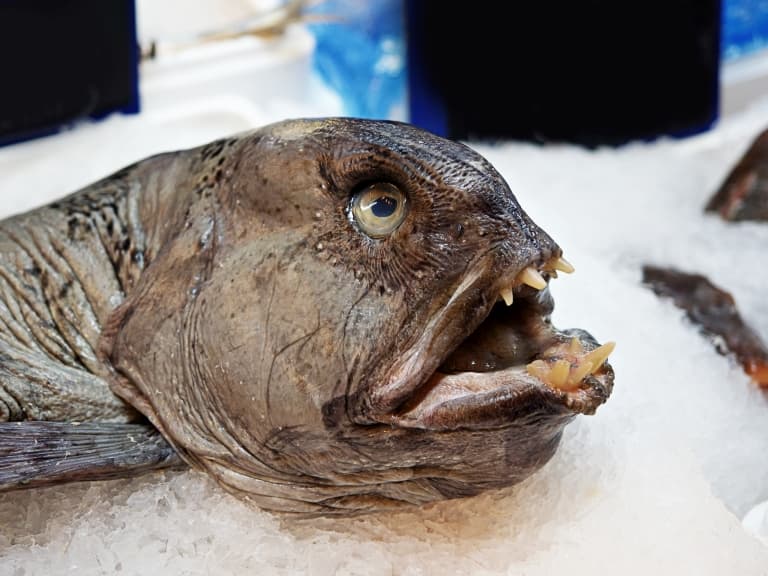Atlantic Wolffish Profile
Atlantic wolffish are a species of large, mostly solitary fish native to the North Atlantic Ocean. They are known for their unusual teeth and breeding behaviours.

Atlantic Wolffish Facts Overview
| Habitat: | Hard ocean floors |
| Location: | East & West coasts of the Atlantic Ocean |
| Lifespan: | Up to 20 years |
| Size: | Up to 1.5 m (about 5 ft) |
| Weight: | Up to 18 kg (about 40 lbs) |
| Appearance: | Long, partially cylindrical bodies with tapered tails and large dorsal and ventral fins |
| Diet: | Molluscs, echinoderms, and crustaceans |
| Predators: | Sharks, large fish, seals, humans |
| Top Speed: | 10kph |
| No. of Species: |
1 |
| Conservation Status: |
Species of Concern |
Atlantic wolffish are a benthic species, meaning that their natural habitat is the bottom of oceans.
Their distinctive teeth, unusual adaptations for aquatic life, and role in the ocean ecosystem make them an important animal to study.
They are currently a species of concern due to overfishing and bycatch, however there is little data on their population as they live on the bottom of the sea bed.
Interesting Atlantic Wolffish Facts
1. Atlantic wolffish get their name from their impressive teeth
They have a set of cone-shaped, fanglike teeth on both their top and bottom jaws. These protruding teeth give them appearance of a wolf or other fearsome predator.

2. They have many different names
Atlantic wolffish are also called seawolves, ocean catfish, devil fish, sea cats, and woofs. Their Pacific Ocean relative (the wolffish, Anarrhichthys ocellatus) is known as the wolf eel.
3. Atlantic wolffish come in a variety of colours
Their skin ranges from blue-grey to green and purple. 1

4. They have several different kinds of teeth
In addition to frontal canine teeth, Atlantic wolffish also have flat teeth in the back of their mouth. Their throats have a series of sharp serrated teeth that help the wolffish digest the sharp shells. 2
5. Atlantic wolffish don’t usually eat other fish
One might expect Atlantic wolffish to prey on other fish, but this is not generally the case. Their diet consists primarily of invertebrates with hard shells such as crabs, sea urchins, mussels, and whelks.
6. They prefer different water depths
Atlantic wolffish can be found on the ocean floor in both shallow and deep water. Some have been found in areas as deep as 500 meters (more than 1600 feet). 3
7. Atlantic wolffish are primarily stationary
This species is a weak swimmer and lacks the pectoral fins that help other fishes move easily through the water. Once an Atlantic wolffish has found a suitable habitat in a cave or crevice, it rarely leaves that area.

8. Hard ocean floors are their home
Unlike other fish who swim up and down in the water column, these fish prefer to make their homes on the rocky floor of the ocean. This provides them with ample access to the prey that make up their diet.
9. Atlantic wolffish live in very cold waters
Water temperatures can drop dramatically during the winter, but this does not impede Atlantic wolffish. They are found in waters as cold as 0° Celsius (32° Fahrenheit) and may be able to withstand temperatures that are even lower.
10. A natural antifreeze runs in their blood
Atlantic wolffish create proteins that enable them to survive in extremely cold temperatures without damaging their body systems. 4
11. They can live in different salinities
Few fish can survive when the salinity, or concentration of salt, in the water around them changes. Atlantic wolffish are able to move between areas of higher and lower salinity without damage. Their bodies excrete salt ions in high-salinity areas and absorb them in low-salinity areas.
12. Atlantic wolffish reproduce through internal fertilization
Most species of fish reproduce when the female releases eggs and the male fertilizes them. Atlantic wolffish are unusual in that the female retains the eggs inside her body during fertilization. She then lays the fertilized eggs in clumps on the rocky ocean floor. 5
13. Female Atlantic wolffish court the males
Another uncommon behaviour of the Atlantic wolffish is its mating rituals. Females will identify a desirable male and “court” him by swimming around the male and rubbing against his body. Once an Atlantic wolffish has chosen a mate, they rarely breed with a different individual.
14. Both male and female Atlantic wolffish are involved in raising young
After the female lays her clutch of eggs, male Atlantic wolffish guard the nest. They stay this way for more than 4 months, protecting the fragile eggs and spawn until they are able to fend for themselves. 6

15. Atlantic wolffish eggs are very large
Most fish eggs are tiny. At 5.5 to 6 millimetres (about 0.2 inches), Atlantic wolffish eggs are among the largest of the fishes.
16. It can take up to 6 years for an Atlantic wolffish to mature
Young Atlantic wolffish develop relatively slowly, and many do not become sexually mature until around 6 years of age.
17. Overfishing and bycatch pose serious risks to them
One of the Atlantic wolffish’s primary predators is humans. Although these fish are a source of food for some people, they are generally caught by accident. Overfishing (harvesting fish faster than their population can recover) and bycatch (accidentally catching a fish while attempting to capture others) have dramatically reduced Atlantic wolffish populations.

18. Atlantic wolffish are in danger
The IUCN lists Atlantic wolffish as a “data deficient” species, meaning that there is not enough information available to determine how many individuals survive. However, the NOAA National Marine Fisheries Service has deemed Atlantic wolffish a “Species of Concern” warranting protection and conservation efforts.
19. They help other species survive
Atlantic wolffish play a crucial role in controlling the populations of green crabs and sea urchins. These species reproduce quickly and can take over an area, consuming so much food that little is available for other animals. Atlantic wolffish reduce the size of crab and urchin populations by feeding on them, ensuring that other species are able to survive.
Atlantic Wolffish Fact-File Summary
Scientific Classification
| Kingdom: | Animalia |
| Phylum: | Chordata |
| Class: | Actinopterygii |
| Order: | Scorpaeniformes |
| Family: | Anarhichadidae |
| Genus: | Anarhichas |
| Species Name: |
Anarhichas Lupus |
Fact Sources & References
- United States Fish and Wildlife Service. Fishes of the Gulf of Maine. Fishery Bulletin No. 74, revision 1.1. United States Government Printing Office; 2002.
- Government of Canada. Wolffish: What you need to know. Accessed February 4, 2022.
- O’Dea NR, Haedrich RL. COSEWIC status report on the Atlantic wolffish Anarhichas lupus in Canada. In COSEWIC Assessment and Status Report on the Atlantic wolffish Anarhichas lupus in Canada. Committee on the Status of Endangered Wildlife in Canada; 2000.
- Le François NR, Lamarre SG, Blier PU. Tolerance, growth and haloplasticity of the Atlantic wolffish (Anarhichas lupus) exposed to various salinities. Aquaculture. 2004:236(4):659-675.
- Johannessen T, Gjøsæter J, Moksness E. Reproduction, spawning behaviour and captive breeding of the common wolffish Anarhichas lupus L. Aquaculture. 1993;115(2):41-51.
- Conservation Law Foundation. Atlantic Wolffish. Accessed February 4, 2022.
